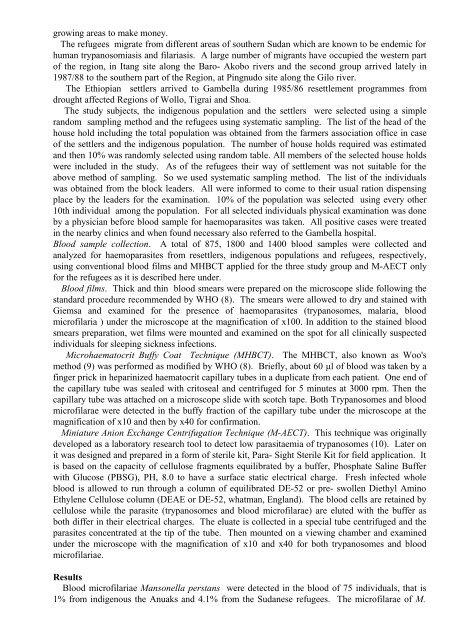Original article - Ethiopian Review
Original article - Ethiopian Review
Original article - Ethiopian Review
- No tags were found...
Create successful ePaper yourself
Turn your PDF publications into a flip-book with our unique Google optimized e-Paper software.
growing areas to make money.The refugees migrate from different areas of southern Sudan which are known to be endemic forhuman trypanosomiasis and filariasis. A large number of migrants have occupied the western partof the region, in Itang site along the Baro- Akobo rivers and the second group arrived lately in1987/88 to the southern part of the Region, at Pingnudo site along the Gilo river.The <strong>Ethiopian</strong> settlers arrived to Gambella during 1985/86 resettlement programmes fromdrought affected Regions of Wollo, Tigrai and Shoa.The study subjects, the indigenous population and the settlers were selected using a simplerandom sampling method and the refugees using systematic sampling. The list of the head of thehouse hold including the total population was obtained from the farmers association office in caseof the settlers and the indigenous population. The number of house holds required was estimatedand then 10% was randomly selected using random table. All members of the selected house holdswere included in the study. As of the refugees their way of settlement was not suitable for theabove method of sampling. So we used systematic sampling method. The list of the individualswas obtained from the block leaders. All were informed to come to their usual ration dispensingplace by the leaders for the examination. 10% of the population was selected using every other10th individual among the population. For all selected individuals physical examination was doneby a physician before blood sample for haemoparasites was taken. All positive cases were treatedin the nearby clinics and when found necessary also referred to the Gambella hospital.Blood sample collection. A total of 875, 1800 and 1400 blood samples were collected andanalyzed for haemoparasites from resettlers, indigenous populations and refugees, respectively,using conventional blood films and MHBCT applied for the three study group and M-AECT onlyfor the refugees as it is described here under.Blood films. Thick and thin blood smears were prepared on the microscope slide following thestandard procedure recommended by WHO (8). The smears were allowed to dry and stained withGiemsa and examined for the presence of haemoparasites (trypanosomes, malaria, bloodmicrofilaria ) under the microscope at the magnification of x100. In addition to the stained bloodsmears preparation, wet films were mounted and examined on the spot for all clinically suspectedindividuals for sleeping sickness infections.Microhaematocrit Buffy Coat Technique (MHBCT). The MHBCT, also known as Woo'smethod (9) was performed as modified by WHO (8). Briefly, about 60 μl of blood was taken by afinger prick in heparinized haematocrit capillary tubes in a duplicate from each patient. One end ofthe capillary tube was sealed with critoseal and centrifuged for 5 minutes at 3000 rpm. Then thecapillary tube was attached on a microscope slide with scotch tape. Both Trypanosomes and bloodmicrofilarae were detected in the buffy fraction of the capillary tube under the microscope at themagnification of x10 and then by x40 for confirmation.Miniature Anion Exchange Centrifugation Technique (M-AECT). This technique was originallydeveloped as a laboratory research tool to detect low parasitaemia of trypanosomes (10). Later onit was designed and prepared in a form of sterile kit, Para- Sight Sterile Kit for field application. Itis based on the capacity of cellulose fragments equilibrated by a buffer, Phosphate Saline Bufferwith Glucose (PBSG), PH, 8.0 to have a surface static electrical charge. Fresh infected wholeblood is allowed to run through a column of equilibrated DE-52 or pre- swollen Diethyl AminoEthylene Cellulose column (DEAE or DE-52, whatman, England). The blood cells are retained bycellulose while the parasite (trypanosomes and blood microfilarae) are eluted with the buffer asboth differ in their electrical charges. The eluate is collected in a special tube centrifuged and theparasites concentrated at the tip of the tube. Then mounted on a viewing chamber and examinedunder the microscope with the magnification of x10 and x40 for both trypanosomes and bloodmicrofilariae.ResultsBlood microfilariae Mansonella perstans were detected in the blood of 75 individuals, that is1% from indigenous the Anuaks and 4.1% from the Sudanese refugees. The microfilarae of M.




![to read the full report [pdf, Amharic] - Ethiopian Review](https://img.yumpu.com/52737829/1/190x245/to-read-the-full-report-pdf-amharic-ethiopian-review.jpg?quality=85)











